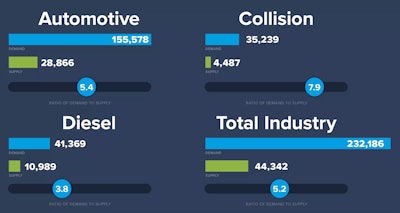A lack of diesel technicians has been a Top 10 concern of motor carriers for the last two years, according annual surveys conducted by the American Transportation Research Institute (ATRI), but this is far from a trucking-specific issue.
The supply of new entrant technicians from automotive post-secondary education programs in the U.S. dropped 11.8% (to 28,866) in 2021, widening current and projected shortfalls of professionals needed to service the nation’s automotive fleet, according to TechForce Foundation’s 2022 Transportation Technician Supply & Demand Report. The supply of program graduates/completions slipped 2.6% and 0.4%, respectively, in the diesel and collision repair segments but has fallen by a combined 17% over the past five years.
Post-secondary programs are an important pipeline to the diesel trade. According to the 2022 State of Diesel Technicians report, a survey-based report produced by CCJ parent company Randall Reilly and sponsored by Shell Lubricant Solutions, about 42% of current technicians completed a vocational/trade program in diesel engine repair, while 44% came to the field with a high school diploma and entered into an apprenticeship.
The worsening technician supply picture – with combined completions dropping from 48,208 in 2020 to 44,052 in 2021 – overshadows a strong year-over-year rebound in technician employment in the automotive (+4.2%) and diesel (+6.5%) repair segments. Total employment of collision repair technicians dropped 0.7% percent, however, continuing a six-year decline.
TechForce estimates demand for new entrant automotive/diesel/collision repair technicians – for new positions, replacements for occupational separations and unfilled positions from prior years – will reach 232,000 in 2022 and total well over 900,000 through 2026.

Among diesel, automotive and collision technician career fields, diesel is in the better position, seeing growth in demand and supply. However, the influx of interest in the diesel technician field seems to come at the expense of all the others, said Craig Settle, who authored the report.
“The rumor has been circulating over the last few years that you can make more money as a technician in the diesel/trucking industry than you can in the auto industry. So, is that true? The answer is yes,” he said, “and the margin of difference is most apparent when starting out as a new entry-level technician. (Money) is the attraction to the diesel sector. Higher starting wages are a huge influence when it comes to young men and women deciding on starting into a career.”
Starting wages in 2021 for an automotive technician are averaging around $14 an hour, Settle said, while starting wages for a diesel technician are $17 an hour.
“When you are first entering the workforce, $3 an hour is very significant. That $3 an hour difference between the two industry segments is maintained through the lowest 25% paid segment of workers, which means it is in effect at least for the first two to three years of a career,” he said. “Starting wages at pretty much any business now are $15 per hour, with no training, and these jobs are still going unfilled in many cases. No previous experience necessary; McDonalds, Burger King, Lowe’s, and the list goes on and on.”
When it comes to average annual earnings between the two careers, automotive technicians are at $48,000, while diesel technicians are at $53,000.
“I believe this is why we are seeing a higher interest in diesel careers than automotive,” Settle said, “and I believe this message gained even more traction in 2020-2021.”
Collision completions have been dropping year-over-year since 2013, when completions were at 7,469. They dropped to 4,487 in 2021 – a 40% decrease.
The ratio of demand to supply with collision technicians, which Settle pegged at 7.9 to 1 – “a sobering number,” he said – however, is somewhat mitigated by the fact that traditionally, more workers enter the collision industry without post-secondary training than is seen in the automotive and diesel sectors. What cannot be mitigated is sagging demand for their services.
“… for the past few years, we have been hearing how the increased implementation of more advanced safety systems will result in less accidents,” he said. “It is possible that we are seeing the positive effect of this.”

